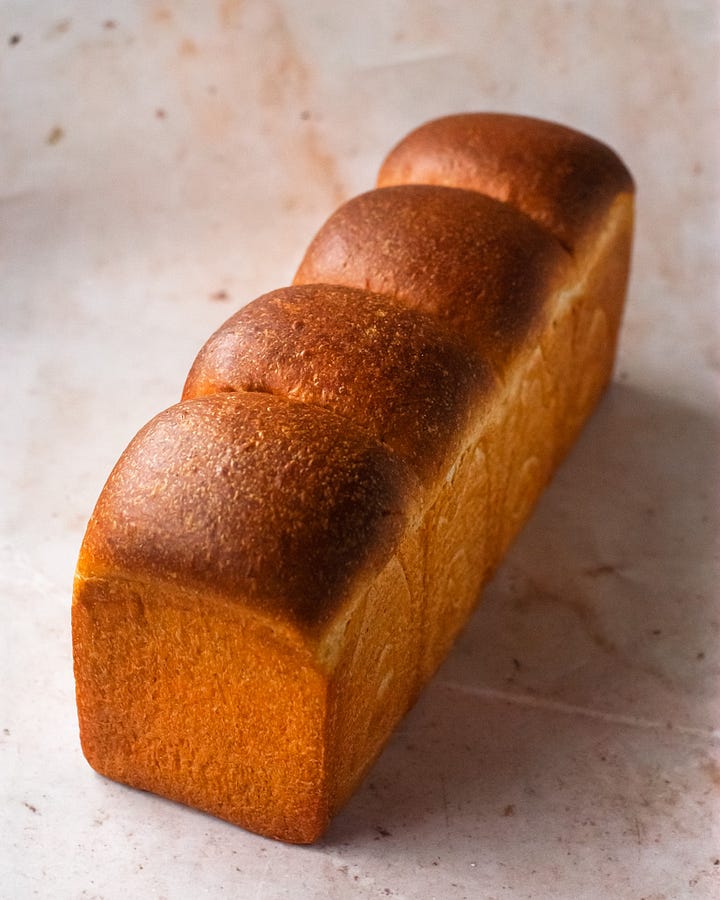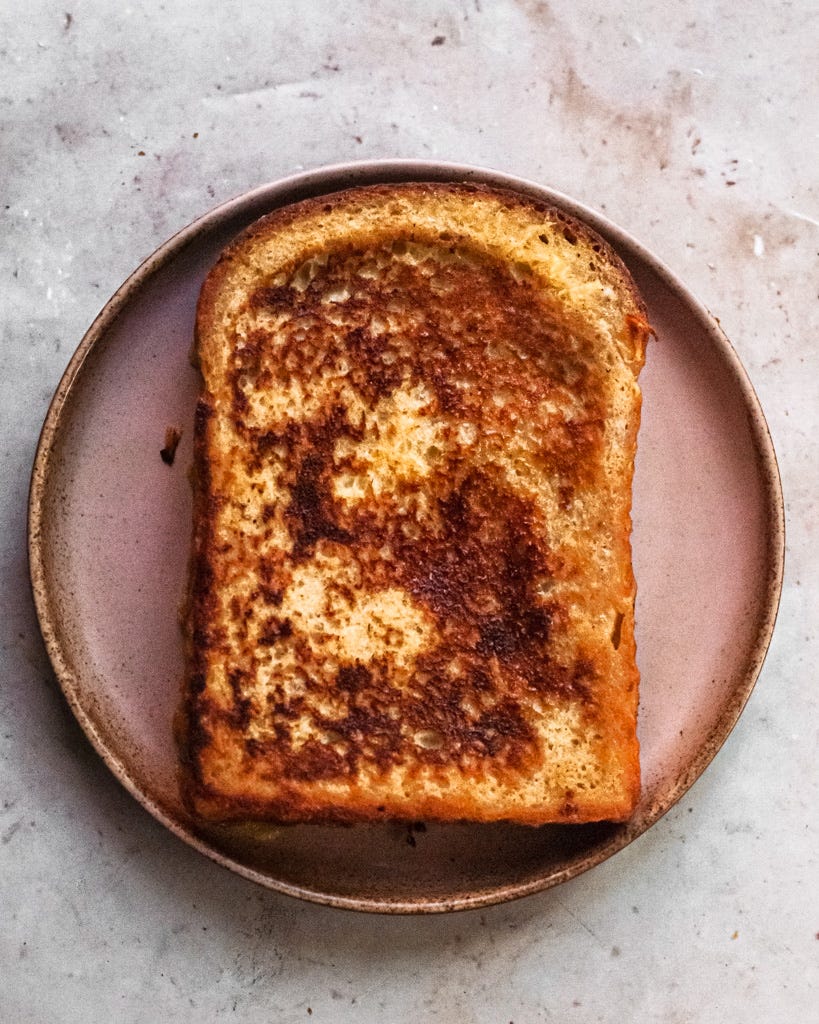Hello friends! Thank you for reading Cook Til Delicious newsletter, the space where I’m talking about the baking and baking-adjacent topics currently occupying my brain. If you’d like to receive the newsletter directly to your inbox, subscribe for free!
If you’d like to directly support the work that goes behind developing and testing all the recipes on the newsletter and the blog, consider upgrading to a paid subscription. Paid subscribers also receive access to extra content, such as chats/Q&A’s/exclusive recipes. My work is reader-supported and I thank you in advance for your consideration!
Do you have “house” recipes? You know the ones — the banana bread always on the counter, Dad’s secret BBQ sauce, the chocolate chip cookies you bring to parties. Familiar and comfortable, they taste like home.
This soft sandwich bread is one of our house recipes. It has developed organically to meet the current needs of our household, using ingredients we always have on hand and following a straightforward schedule that fits our daily routine. I’m sure that if you ask me about this recipe in a year or two, I’ll have made further adjustments based on our family’s ever-evolving tastes.


For this loaf, I rely on a large percentage of sourdough starter (you can use active starter or discard that’s not too soupy or acidic-smelling) for flavor and a little instant yeast for predictability. (This combination of wild and commercial yeast yields what I call a hybrid loaf, or hy-bread. HA!) The crumb stays soft and sturdy for several days. I typically bake the loaf on Monday, use it for sandwiches for the next several days, and — if there is any left — make French toast on Friday.
(Psst, I’m sharing my French toast method as a bonus for paid subscribers!)
This formula is, like many of my house recipes, forgiving and flexible. When I’m out of heavy cream I will sub sour cream or even more milk. I’ve successfully used many different wheat varieties for the whole wheat flour (spelt, emmer, einkorn, whole wheat, rye…). Sometimes I sub in honey for the sugar. If I’ve got a lazy day at home and the majority of my starter is pretty active, I’ll skip the instant yeast entirely (the final proof usually takes about an hour longer in this case).
Before you get too cavalier, though, I suggest making this loaf as written a couple times to learn how it behaves in your kitchen. As with any yeast/sourdough recipe, timings can vary widely depending on the strength of your starter and the ambient temperature. But once you know what to expect, go crazy and make it your own house bread!
Hy-bread
Makes one 13x4 loaf (this is the pan I use); if using a 9x4 pan multiply all ingredients by 0.67.
Ingredients:
375g sourdough starter or starter discard (100% hydration)1
218g whole milk or buttermilk (I prefer buttermilk!), cold2
38g heavy cream, cold
30g water
35g nonfat milk powder
55g sugar
4g instant yeast
12g salt
410g bread flour
113g whole wheat flour
60g unsalted butter/schmaltz/oil, room temperature (I like schmaltz!)
Method:
Mix the dough: Combine all ingredients except fat in the bowl of a stand mixer fit with the dough hook. Mix on medium-low until smooth, about 7 minutes. Cover the bowl and rest the dough for 5 minutes. (This keeps the dough and mixer from overheating.)
With the mixer on low, add the fat about a third at a time, waiting until each portion is incorporated before adding the next. Once all the fat has been added, mix on medium-low until dough is very smooth and passes the windowpane test, about 5 minutes.
Bulk proof: Transfer the dough to a clean and lightly oiled container. Cover and bulk ferment until noticeably risen, though not doubled (in my low-70s environment, about 90 minutes).
Divide and shape: Divide the dough into 4 equal pieces and preshape gently into rounds. To shape the sandwich loaf, take one round and place it smooth side down on a clean work surface (I like to use a silicone mat). Roll the dough into a rectangle roughly 4”x14”, aiming to degas the dough well. (Roll from the center out, which should push the air bubbles to the edges. Pop any air bubbles you see; this will help create a tight and smooth crumb.) Fold the two long edges to the center, slightly overlapping. Roll back into a rectangle about 4”x14”, again doing your best to fully degas the dough, then roll up tightly like a jelly roll. Pinch seam to seal. Repeat with other three portions.
Final proof: Transfer rolls to a lightly greased 13x4 pullman pan, seam sides down. Mist the surface with oil and cover loosely with plastic. Allow to rise at room temperature until dough roughly triples in volume and just reaches the top of the tin (in my low-70s environment, 2.5-3 hours).
Preheat and bake: About 30 minutes before baking, preheat oven to 400F with a rack in the middle. After the dough has finished proofing, brush the top lightly with milk, transfer to oven, and bake for 20 minutes. After 20 minutes, reduce the heat to 350F and continue baking for 15-20 minutes, or until the internal temperature is at least 195F. If the loaf is browning too quickly, tent a piece of foil over the top to keep from burning.
When the loaf is finished, immediately remove from the pan and turn onto a wire rack. Brush melted butter over the top and sides while the loaf is still warm, if desired (this helps create a soft crust). Allow to cool completely before slicing. Store leftovers in a sealed plastic bag.
Currently reading:
from talks about regional recipe writing and using hyperlocal ingredients. She has a great approach for testing the flours specific to your region, which I always encourage you to try!Currently baking: This week I made my strawberry pavlova and topped it with buttermilk whipped cream, a little yuzu curd, and a tart strawberry-rhubarb compote. A perfect springing-into-summer dessert!
When using discard for this loaf, I prefer using something that’s within a week old, not overly runny or acidic-smelling.
I use my dairy products straight from the fridge as I find the long mixing time warms up the dough sufficiently.






Just pulled this out of the oven; smells divine! Will cut into for breakfast in the morning! Thanks for this great recipe using so much discard!!
Hi Ruth, thanks for sharing, this loaf looks so flavourful and tender. Love the way you’ve incorporated double cream and a good amount of starter. 🍞 Keen to give this a go.